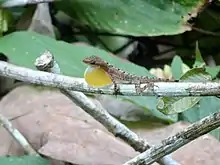Anolis apletophallus
Anolis apletophallus is a species of anoles, iguanian lizards in the family Dactyloidae native to Panama. The species was split from Anolis limifrons in Köhler and Sunyer (2008).[2] It has been reported in Panama, Honduras and Colombia.[3] A decline in its population in Panama over a 40-year timespan has been attributed to changes in local climate, with years following El Niño negatively affecting the species.[4]
| Anolis apletophallus | |
|---|---|
 | |
| Scientific classification | |
| Domain: | Eukaryota |
| Kingdom: | Animalia |
| Phylum: | Chordata |
| Class: | Reptilia |
| Order: | Squamata |
| Suborder: | Iguania |
| Family: | Dactyloidae |
| Genus: | Anolis |
| Species: | A. apletophallus |
| Binomial name | |
| Anolis apletophallus Köhler and Sunyer, 2008 | |
History and taxonomy
Only fairly recently recognized as its own species, the specific epithet of this species translates to "immense penis", due to its large bi-lobed hemipenis as an identifying feature described by Köhler and Sunyer (2008).[2]
Description
A. apletophallus is a relatively small mainland anole getting to about 40-45 mm (snout-to-vent), but have a large dewlap relative to their body size. The species displays dewlap polymorphism, where some populations' dewlaps are orange, while others are white with a basal orange dot, and others still display both dewlap morphs. No genetic differences were found between individuals with different dewlap morphs.[5] They are rather short-lived with a 9 month generation time making them an annual species, with the adults reaching maturity in about 4-6 months.
Distribution and habitat
A. apletophallus is a mainland species native to Panama and may also be found in Colombia.[6][3]
References
- Ibáñez, R., Jaramillo, C., Köhler, G., Castañeda, M.R. & Velasco, J. (2020). "Anolis apletophallus ". The IUCN Red List of Threatened Species 2020: e.T203076A2759909. https://www.iucnredlist.org/species/203076/2759909. Downloaded on 29 March 2021.
- Köhler, Gunther; Sunyer, Javier (March 2008). "Two New Species of Anoles Formerly Referred to as Anolis Limifrons (Squamata: Polychrotidae)". Herpetologica. 64 (1): 92–108. doi:10.1655/07-027.1. ISSN 0018-0831. S2CID 86734273.
- "Anolis apletophallus Köhler & Sunyer, 2008". www.gbif.org (in Spanish). Retrieved 2020-02-16.
- Stapley, Jessica; Garcia, Milton; Andrews, Robin M. (2015-02-11). Navas, Carlos A (ed.). "Long-Term Data Reveal a Population Decline of the Tropical Lizard Anolis apletophallus, and a Negative Affect [sic] of El Nino Years on Population Growth Rate". PLOS ONE. 10 (2): e0115450. Bibcode:2015PLoSO..1015450S. doi:10.1371/journal.pone.0115450. ISSN 1932-6203. PMC 4325001. PMID 25671423.
- Stapley, Jessica; Wordley, Claire; Slate, Jon (2011-01-01). "No Evidence of Genetic Differentiation Between Anoles With Different Dewlap Color Patterns". The Journal of Heredity. 102 (1): 118–24. doi:10.1093/jhered/esq104. PMID 20861275.
- "Anolis apletophallus Köhler & Sunyer 2008 - Encyclopedia of Life". eol.org. Retrieved 2020-05-22.
